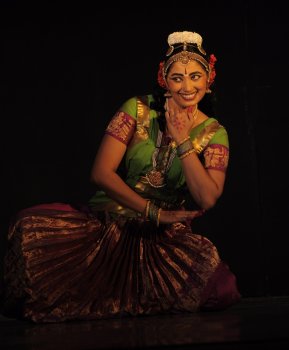
|   |

|   |
The questions of ‘Panchali’ - Smitha Shenoy e-mail: shenoy.smita@gmail.com March 11, 2014 A unique representation of Panchali, the prominent character of Mahabharata was staged through solo Bharatanatyam by Bhramari Shivaprakash in Mangalore and Udupi recently under the auspices of Nadanrithya School of Dance and Samooha Artists, Udupi. It was the first show of Prof. Udhyavara Madhava Acharya’s composition of ‘Panchali’ in a ‘verse-prose’ format written exclusively for such solo performances in any Indian classical dance form. The composition is chosen from 20 similar productions of the author. All are flexible to subtle changes found in each dance form. This makes them a worthy script for most classical dance presentations. The wizard writer though not a dancer himself, has understood such a need for his composition to be more functional. The purpose of the literature here is to flourish into a visual form and tell the story with all possible awakening of feelings it could. Bhramari Shivaprakash has provided justice to the intention of the author and the story. The prose rendering with apt voice modulation by Prof. Madhava Acharya with the vocal musical support by Sheela Divakar enhanced the appeal of the dance drama. Bhramari is a disciple of Dr. Vasundhara Doraswamy who had tried out the same script for Yakshagana background orchestra with Bharatanatyam earlier in 2002.  Simple but powerful language painted the throbbing life of epic heroine Draupadi in emotions of different hues. The explanations, dialogues and soliloquies made the drama vivid. The expressions and body movements of the dancer never stepped out of the ‘classical’ boundary. Since the language was Kannada, it escorted the viewer into the realm of intended feelings naturally and effortlessly. A synergy of effective language, pure classical dance grammar, suitable music and facial expressions drew the essence of the already eventful life of Draupadi. The depiction of each strand of strange situations that occurred in her life contributed to the totality of the drama and succeeded in making it an emotionally moving performance. The characterization of Draupadi as such processes most feminine qualities. As a pampered little princess of King Drupada who got her from the Fire God, as a dreamy maiden longing for love, as a tender bride who was asked to be shared among five men, as a shattered female when lost like a property in game of dice by her brave men, as a lady humiliated in the open court of Dhritarastra and finally an avenging vamp to Kauravas by setting her blood smeared hair with a bone comb, towards the wounded queen who leads to the end of the epic in just war, till she died in the snow - her emotions rose and fell frequently. It was a testimony to the dancer’s ability that she performed it without losing the sharpness of the edges of the story. Each of the events was offered with clarity and beauty in the two-hour solo performance. The dance drama continued to be a reminder of questions Draupadi raised like, why and how she could not receive the reverence as a princess and queen of Hastinavati, why she was humiliated in a most demonic manner. Why was she denied the basic fair treatment as a lady, or as simply a human? Smitha Shenoy is the Head of Journalism Department, Besant College, Mangalore. |